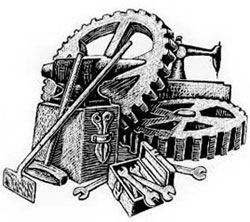What better way to spend your Friday than catching up on social history?
We continue with our weekly round-up of interesting social history news and projects around the web.
Links from Leah
I’ve been a big fan of the British Museum’s A History of the World in 100 Objects podcast series since its inception, but all of the objects so far were created too early to have much to tell us about the social history of the United States. That’s all changing now that the series is addressing objects and themes from the 1600s–1800s. Last Friday’s object was an Akan drum, the oldest African-American object in the British Museum’s collection, created by the Akan people of West Africa and transported to Virginia sometime around 1735. The podcast briefly traces the forced migration of Africans to the New World, as well as the complicated relationships that brought the drum first to the British colonies and then to the British Museum. The highlight of the podcast for me was hearing the recreation of music featuring this style of drum; the music was originally transcribed from African slaves in Jamaica by the man who collected the drum.
Iconic Photos: This lively blog gives the back story to many famous photos and makes the case for why other photographs are important even though you might not know them. The photographs are not just of U.S. history–they span world events and popular culture. Each blog post includes a fun social media feature, where readers can vote Yay or Nay on whether the photograph is “iconic enough.” A good starting point is the post of Oliver Sipple, the gay veteran who saved President Gerald Ford’s life in 1975 by intercepting a would-be assassin; in the ensuing press coverage he was outed, which tragically led to the destruction of Sipple’s personal life and his eventual suicide.
Links from Ellen
This New York Times Metro article about St. Peter’s catholic church, on Barclay Street in lower Manhattan, provides a nice social history angle on the controversy over the proposed Islamic community center near Ground Zero. It details the strikingly similar history of anti-Catholic opposition to the building of the church in 1785 (it’s the oldest Catholic church in New York State) and how Father Kevin Madigan has used those parallels in letters and sermons to his parishioners.
This week we also discovered docsteach.org, a terrific new resource from the National Archives and Records Administration (NARA). It provides tools for teachers to construct and share classroom activities using digitized NARA documents and, crucially, organizes those tools in ways that reflect current thinking about historical thinking and analysis skills. The activities you create are meant to be completed online, and students can email their work to the instructor. A major  drawback may be the documents themselves–many are nifty but more likely to illuminate events rather than the  larger historical understandings teachers will want their students to gain. Also, there does not seem to be a way to modify or edit the documents, which we know is absolutely critical for many teachers, particularly those whose students have various literacy challenges. But all in all, a very worthy new addition to the burgeoning universe of history education tools.
Last 5 posts by Leah Nahmias
- Teaching "What This Cruel War Was Over" - March 28th, 2011
- State of Siege and Public Memory at Ole Miss - March 25th, 2011


